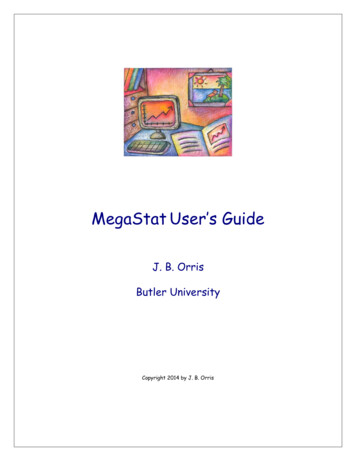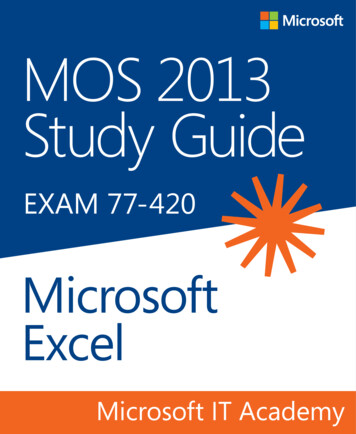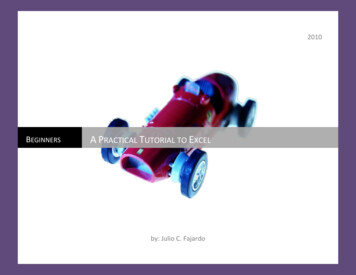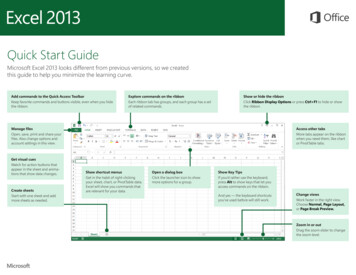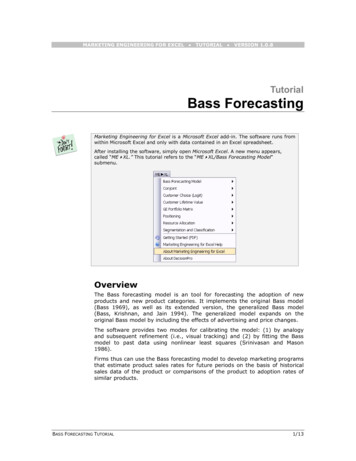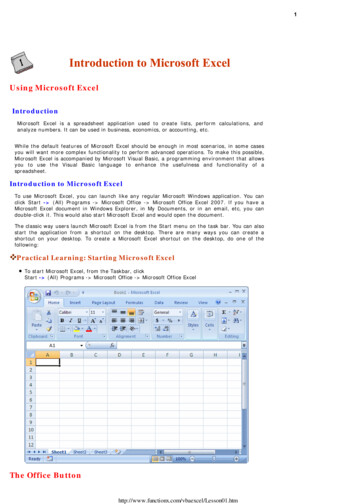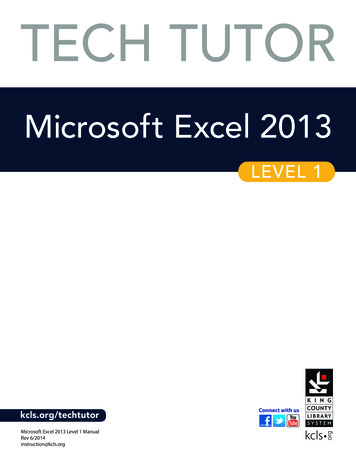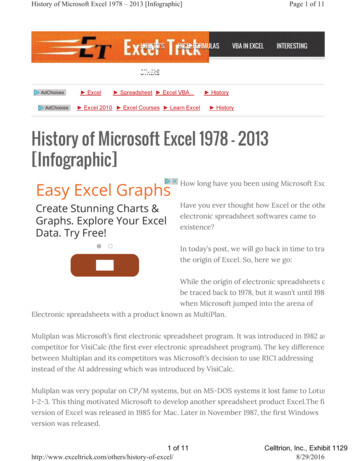
Transcription
Microsoft excel 2013 advanced tutorial pdf
Microsoft excel 2013 advanced tutorial pdf free download. How to download ms excel 2013 for free. Excel 2013 setup.Full PDF PackageDownload Full PDF PackageThis PaperA short summary of this paper4 Full PDFs related to this paperDownloadPDF Pack You're Reading a Free Preview Page 2 is not shown in this preview. Version of Microsoft Office Microsoft Office 2007Microsoft Office 2007 applications shown on Windows Vista – clockwise from top left: Word,Excel, OneNote and PowerPoint. These four programs make up the Home and Student edition.Developer(s)MicrosoftInitial releaseJanuary 30, 2007; 15 years ago (2007-01-30)[1]Final releaseService Pack 3 (12.0.6612.1000)[2] / October 25, 2011; 10 years ago (2011-10-25) Operating system Windows XP SP2 or later Windows Server 2003 SP1 or laterWindows Vista Windows Server 2008 Windows 7 Windows Server 2008 R2 Windows 8 Windows Server 2012 Windows 8.1 Windows Server 2012 R2 Windows 10 [3]PlatformIA-32[3]PredecessorMicrosoft Office 2003 (2003)SuccessorMicrosoft Office 2010 (2010)Available inEnglish, Arabic, Simplified Chinese, Traditional Chinese, Czech, Danish, Dutch,Finnish, French, German, Greek, Hebrew, Hindi, Hungarian, Italian, Japanese, Korean, Lithuanian, Norwegian (Bokmål), Polish, Portuguese, Romanian, Russian, Slovak, Slovenian, Spanish, Swedish, Thai, Turkish, and Ukrainian.[4]TypeOffice wnload-office-2007 Microsoft Office 2007 (codenamedOffice 12[5]) is an office suite for Windows, developed and published by Microsoft. It was officially revealed on March 9, 2006 and was the 12th version of Microsoft Office. It was released to manufacturing on November 3, 2006;[6] it was subsequently made available to volume license customers on November 30, 2006,[7][8] and later to retail onJanuary 30, 2007,[1] shortly after the completion of Windows Vista. The ninth major release of Office for Windows, Office 2007 was preceded by Office 2003 and succeeded by Office 2010. The Mac OS X equivalent, Microsoft Office 2008 for Mac, was released on January 15, 2008. Office 2007 introduced a new graphical user interface called theFluent User Interface, which uses ribbons and an Office menu instead of menu bars and toolbars.[9] Office 2007 also introduced Office Open XML file formats as the default file formats in Excel, PowerPoint, and Word. The new formats are intended to facilitate the sharing of information between programs, improve security, reduce the size ofdocuments, and enable new recovery scenarios.[10] Office 2007 is incompatible with Windows 2000 and earlier versions of Windows. Office 2007 is compatible with Windows XP SP2 or later, Windows Server 2003 SP1 or later, Windows Vista, Windows Server 2008, Windows 7, Windows Server 2008 R2, Windows 8, Windows Server 2012, Windows8.1, Windows Server 2012 R2 and Windows 10.[3] It is the last version of Microsoft Office to support the 64-bit versions of Windows XP and Windows Server 2003, the 32-bit versions of Windows XP SP2 and Windows Server 2003 SP1 and Windows Vista before SP1 as the following version, Microsoft Office 2010 only supports Windows XP SP3,Windows Server 2003 SP2, and Windows Vista SP1 or later.[11] Office 2007 includes new applications and server-side tools, including Microsoft Office Groove, a collaboration and communication suite for smaller businesses, which was originally developed by Groove Networks before being acquired by Microsoft in 2005. Also included is SharePointServer 2007, a major revision to the server platform for Office applications, which supports Excel Services, a client-server architecture for supporting Excel workbooks that are shared in real time between multiple machines, and are also viewable and editable through a web page. With Microsoft FrontPage discontinued, Microsoft SharePointDesigner, which is aimed towards development of SharePoint portals, becomes part of the Office 2007 family. Its designer-oriented counterpart, Microsoft Expression Web, is targeted for general web development. However, neither application has been included in Office 2007 software suites. Speech recognition functionality has been removed fromthe individual programs in the Office 2007 suite, as Windows Speech Recognition was integrated into Windows Vista. Windows XP users must install a previous version of Office to use speech recognition features.[12] According to Forrester Research, as of May 2010, Microsoft Office 2007 is used in 81% of enterprises it surveyed (its samplecomprising 115 North American and European enterprise and SMB decision makers).[13] Mainstream support for Office 2007 ended on October 9, 2012, and extended support ended on October 10, 2017.[14] On August 27, 2021, Microsoft announced that Outlook 2007 and Outlook 2010 would be cut off from connecting to Microsoft 365 Exchangeservers on November 1, 2021.[15] Development Microsoft announced Beta 1 of Office 2007 with the revelation of the ribbon user interface on March 9, 2006, at CeBIT in Germany.[16] Beta 2 was announced by Bill Gates at WinHEC 2006, and was initially released to the public at no cost from Microsoft's web site. However, because of anunprecedented number of downloads, a fee of 1.50 was introduced for each product downloaded after August 2, 2006, The beta was updated on September 14, 2006, in Beta 2 Technical Refresh (Beta2TR). It included an updated user interface, better accessibility support, improvements in the robustness of the platform, and greater functionality.Office 2007 was released to volume licensing customers on November 30, 2006, and to the general public on January 30, 2007.[1] Mainstream support ended on October 9, 2012.[17] Extended support ended on October 10, 2017.[17] Service packs Since the initial release of Microsoft Office 2007, three service packs containing updates as well asadditional features have been released. Microsoft Office 2007 Service Packs are cumulative, so previous Service Packs are not a prerequisite for installation.[18] Microsoft Office 2007 Service Pack 1 was released on December 11, 2007.[19] Official documentation claims that SP1 is not simply a rollup of publicly released patches, but that it alsocontains fixes for a total of 481 issues throughout the entire Office suite.[20] Microsoft Office 2007 Service Pack 2 was released on April 28, 2009.[21] It added improved support for ODF, XPS and PDF standards, and included several bug fixes.[21][22] Microsoft Office 2007 Service Pack 3 was released on October 25, 2011.[23] Editions Table ofMicrosoft Office 2007 Editions [24][25] Programs and Features Basic Home and Student Standard Small Business Professional Professional Plus Enterprise Ultimate Licensing scheme OEM Retail and OEM Retail and volume Retail, OEM and volume Retail and OEM Volume Volume Retail Word 2007 Yes Yes Yes Yes Yes Yes Yes Yes Excel 2007 YesYes Yes Yes Yes Yes Yes Yes PowerPoint 2007 Viewer only Yes Yes Yes Yes Yes Yes Yes Outlook 2007 Yes No Yes Yes Yes Yes Yes Yes OneNote 2007 No Yes No No No No Yes Yes Picture Manager 2007 No No Yes Yes Yes Yes Yes Yes Publisher 2007 No No No Yes Yes Yes Yes Yes Access 2007 No No No No Yes Yes Yes Yes InfoPath 2007 No No No NoNo Yes Yes Yes Communicator 2007 R2 No No No No No Yes Yes No Groove 2007 No No No No No No Yes Yes Project 2007 No No No No No No No No SharePoint Designer 2007 No No No No No No No No Visio 2007 Viewer only Viewer only Viewer only Viewer only Viewer only Viewer only Viewer only Viewer only Office Customization Tool (OCT)2007 No No Volume licensing only[26] Volume licensing only[26] No Yes[26] Yes[26] No Upgrade MSRP ? — 239.95[25] 279.95[25] 329.95[25] ? ? 539.95[25] Full MSRP ? 149.95[25] 399.95[25] 449.95[25] 499.95[25] ? ? 679.95[25] 1 Office Customization Tool is used to customize the installation of Office 2007 by creating a WindowsInstaller patch file (.MSP) and replacing the Custom Installation Wizard and Custom Deployment Wizard included in earlier versions of the Office Resource Kit that created a Windows Installer Transform (.MST).[26] Volume licensing Eligible employees of companies with volume license agreements for Microsoft Office receive additional tools,including enterprise content management, electronic forms, Information Rights Management capabilities and copies for use on a home computer.[27] New features User interface The new user interface (UI), officially known as Fluent User Interface,[28][29] has been implemented in the core Microsoft Office applications: Word, Excel, PowerPoint,Access, and in the item inspector used to create or edit individual items in Outlook. These applications have been selected for the UI overhaul because they center around document authoring.[30] The rest of the applications in the suite changed to the new UI in subsequent versions.[31] The default font used in this edition is Calibri. Originalprototypes of the new user interface were revealed at MIX 2008 in Las Vegas.[32] Office button The Office 2007 button, located on the top-left of the window, replaces the File menu and provides access to functionality common across all Office applications, including opening, saving, printing, and sharing a file. It can also close the application. Userscan also choose color schemes for the interface. A notable accessibility improvement is that the Office button follows Fitts's law.[33] Ribbon Main article: Ribbon (computing) The ribbon, a panel that houses a fixed arrangement of command buttons and icons, organizes commands as a set of tabs, each grouping relevant commands. The ribbon ispresent in Microsoft Word 2007, Excel 2007, PowerPoint 2007, Access 2007 and some Outlook 2007 windows. The ribbon is not user customizable in Office 2007. Each application has a different set of tabs that exposes functions that the application offers. For example, while Excel has a tab for the graphing capabilities, Word does not; instead it hastabs to control the formatting of a text document. Within each tab, various related options may be grouped together. The ribbon is designed to make the features of the application more discoverable and accessible with fewer mouse clicks[34] as compared to the menu-based UI used prior to Office 2007. Moving the mouse scroll wheel while on any ofthe tabs on the ribbon cycles—through the tabs. The ribbon can be minimized by double clicking the active section's title, such as the Home text in the picture below.[35] Office 2007 does not natively support removing, modifying or replacing ribbon. Third party add-ins, however, can bring menus and toolbars back to Office 2007 or customize theribbon commands. Add-ins that restore menus and toolbars include Classic Menu for Office,[36] ToolbarToggle,[37][38] and Ubitmenu.[39] Others like RibbonCustomizer enable the customization of ribbons.[38] Office 2010 does allow user customization of the ribbon out of the box. The ribbon in Microsoft PowerPoint 2007 running on Windows VistaContextual Tabs Some tabs, called Contextual Tabs, appear only when certain objects are selected. Contextual Tabs expose functionality specific only to the object with focus. For example, selecting a picture brings up the Pictures tab, which presents options for dealing with the picture. Similarly, focusing on a table exposes table-related options in aspecific tab. Contextual Tabs remain hidden except when an applicable object is selected. Live Preview Microsoft Office 2007 also introduces a feature called Live Preview, which temporarily applies formatting on the focused text or object when any formatting button is moused-over. The temporary formatting is removed when the mouse pointer ismoved from the button. This allows users to have a preview of how the option would affect the appearance of the object, without actually applying it. Mini Toolbar The new Mini Toolbar is a small toolbar with basic formatting commands that appears within the document editing area, much like a context menu. When the mouse selects part of the text,Mini Toolbar appears close to selected text. It remains semi-transparent until the mouse pointer is hovered on it, to avoid obstructing what is underneath. Mini Toolbar can also be made to appear by right-clicking in the editing area or via Menu key on keyboard, in which case it appears near the cursor, above or below the traditional context menu.Mini Toolbar is not customizable in Office 2007, but can be turned off. Quick Access Toolbar The Quick Access toolbar (by default) sits in the title bar and serves as a repository of most used functions, such as save, undo/redo and print. It is customizable, although this feature is limited, compared to toolbars in previous Office versions. Any commandavailable in the entire Office application can be added to the Quick Access toolbar, including commands not available on the ribbon as well as macros. Keyboard shortcuts for any of the commands on the toolbar are also fully customizable, similar to previous Office versions. Other UI features Super-tooltips, or screentips, that can house formatted textand even images, are used to provide detailed descriptions of what most buttons do. A zoom slider present in the bottom-right corner, allowing for dynamic and rapid magnification of documents. The status bar is fully customizable. Users can right click the status bar and add or remove what they want the status bar to display.[40] SmartArt SmartArt,found under the Insert tab in the ribbon in PowerPoint, Word, Excel, and Outlook, is a new group of editable and formatted diagrams. There are 115 preset SmartArt graphics layout templates in categories such as list, process, cycle, and hierarchy. When an instance of a SmartArt is inserted, a Text Pane appears next to it to guide the user throughentering text in the hierarchical levels. Each SmartArt graphic, based on its design, maps the text outline, automatically resized for best fit, onto the graphic. There are a number of "quick styles" for each graphic that apply largely different 3D effects to the graphic, and the graphic's shapes and text can be formatted through shape styles and WordArtstyles. In addition, SmartArt graphics change their colors, fonts, and effects to match the document's theme. File formats Office Open XML Main article: Office Open XML Microsoft Office 2007 introduced a new file format, called Office Open XML, as the default file format. Such files are saved using an extra X letter in their extension(.docx/xlsx/pptx/etc.). However, it can still save documents in the old format, which is compatible with previous versions. Alternatively, Microsoft has made available a free add-on known as the Microsoft Office Compatibility Pack that lets Office 2000, XP, and 2003 open, edit, and save documents created under the newer 2007 format.[41] Office OpenXML is based on XML and uses the ZIP file container. According to Microsoft, documents created in this format are up to 75% smaller than the same documents saved with previous Microsoft Office file formats, owing to the ZIP data compression.[42] Files containing macros are saved with an extra M letter in their extension instead(.docm/xlsm/pptm/etc.). PDF Initially, Microsoft promised to support exporting to Portable Document Format (PDF) in Office 2007. However, due to legal objections from Adobe Systems, Office 2007 originally did not offer PDF support out of the box, but rather as a separate free download.[43][44][45] However, starting with Service Pack 2, Officeallows users to natively export PDF files.[46] XPS Office 2007 documents can also be exported as XPS documents. This is part of Service Pack 2 and prior to that, was available as a free plug-in in a separate download.[46] [47] OpenDocument Main article: OpenDocument software Microsoft backs an open-source effort to support OpenDocument inOffice 2007, as well as earlier versions (up to Office 2000), through a converter add-in for Word, Excel and PowerPoint, and also a command-line utility.[48] As of 2008, the project supports conversion between ODF and Office Open XML file formats for all three applications.[49] According to ODF Alliance this support falls short and substantialimprovements are still needed for interoperability in real-world situations.[50][51] Third-party plugins able to read from and write to the ISO-standard Open Document Format (ODF) are available as a separate download.[52][53] Office 2007 Service Pack 2 adds native support for the OpenDocument Format.[54] The ODF Alliance has released testresults on ODF support of Office 2007 SP2,[55] concluding that Office ODF support, both SP2 and other add-ons, have "serious shortcomings that, left unaddressed, would break the open standards based interoperability that the marketplace, especially governments, is demanding". Particularly, SP2 has no support for encrypted ODF files and haslimited interoperability with other ODF spreadsheet implementations. The ISO/IEC 26300 OpenDocument standard specifies encryption of files, which is based on sha1, Blowfish, and RFC 2898. Microsoft Office 2007 SP2 does not support reading and writing encrypted (password protected) ODF files.[55][56][57] Users are presented with a message:“cannot use password protection using the ODF format.”[55][57] The ISO/IEC 26300 OpenDocument standard has no spreadsheet formula language included (or referenced) in the standard specification. Office 2007 SP2 uses the spreadsheet formula language specified in the ISO/IEC 29500 Office Open XML open standard when creating ODFdocuments. According to the ODF Alliance report "ODF spreadsheets created in Excel 2007 SP2 do not in fact conform to ODF 1.1 because Excel 2007 incorrectly encodes formulas with cell addresses. Section 8.3.1 of ODF 1.1 says that addresses in formulas "start with a "[" and end with a "]"." In Excel 2007 cell addresses were not enclosed with thenecessary square brackets."[55] The ISO/IEC 26300 specification states that the semantics and the syntax depends on the used namespace, which is implementation dependent, leaving the syntax implementation defined as well.[58] Microsoft stated that they consider adding support for an official ODF formula language (OpenFormula), once a futureversion of the ISO/IEC 26300 standard specification includes one.[59] Microsoft's ODF spreadsheet support in SP2 is not fully inter-operable with other implementations of OpenDocument, such as the IBM Symphony, which use the non-standardized OpenOffice.org 2.x formula language, and OpenOffice.org 3.x, which uses a draft of OpenFormula.[60]The company had previously reportedly stated that "where ODF 1.1 is ambiguous or incomplete, the Office implementation can be guided by current practice in OpenOffice.org, mainly, and other implementations including KOffice and AbiWord. Peter Amstein and the Microsoft Office team are reluctant to make liberal use of extension mechanisms,even though provided in ODF 1.1. They want to avoid all appearance of an embrace-extend attempt."[61] The EU investigated Microsoft Office OpenDocument Format support to see if it provided consumers greater choice.[62] Metadata In Office 2007, Microsoft introduced the Document Inspector, an integral metadata removal tool that strips Word,Excel, and PowerPoint documents of information such as author name and comments and other "metadata". User assistance system In Microsoft Office 2007, the Office Assistants were eliminated in favour of a new online help system. One of its features is the extensive use of Super Tooltips, which explain in about one paragraph what each functionperforms. Some of them also use diagrams or pictures. These appear and disappear like normal tooltips, and replace normal tooltips in many areas. The Help content also directly integrates searching and viewing Office Online articles. Collaboration features SharePoint Microsoft Office 2007 includes features geared towards collaboration and datasharing. As such, Microsoft Office 2007 features server components for applications such as Excel, which work in conjunction with SharePoint Services, to provide a collaboration platform. SharePoint works with Microsoft Office SharePoint Server 2007, which is used to host a SharePoint site, and uses IIS and ASP.NET 2.0. Excel server exposes ExcelServices, which allows any worksheet to be created, edited and maintained via web browsers. It features Excel Web Access, the client-side component which is used to render the worksheet on a browser, Excel Calculation Service which is the server side component which populates the worksheet with data and perform calculations, and Excel WebServices that extends Excel functionalities into individual web services. SharePoint can also be used to host Word documents for collaborative editing, by sharing a document. SharePoint can also be used to hold PowerPoint slides in a Slide Library, from which the slides can be used as a formatting template. It also notifies users of a slideautomatically in case the source slide is modified. Also by using SharePoint, PowerPoint can manage shared review of presentations. Any SharePoint hosted document can be accessed from the application which created the document or from other applications such as a browser or Microsoft Office Outlook. Groove Microsoft Office 2007 also includesGroove, which brings collaborative features to a peer-to-peer paradigm. Groove can host documents, including presentations, workbooks and others, created in Microsoft Office 2007 application in a shared workspace, which can then be used in collaborative editing of documents. Groove can also be used in managing workspace sessions, includingaccess control of the workspace. To collaborate on one or more documents, a Workspace must be created, and then those who are to work on it must be invited. Any file shared on the workspace are automatically shared among all participants. The application also provides real-time messaging, including one-to-one as well as group messaging, andpresence features, as well as monitoring workspace activities with alerts, which are raised when pre-defined set of activities are detected. Groove also provides features for conflict resolution for conflicting edits. Schedules for a collaboration can also be decided by using a built-in shared calendar, which can also be used to keep track of the progressof a project. However, the calendar is not compatible with Microsoft Outlook. Themes and Quick Styles Microsoft Office 2007 places more emphasis on Document Themes and Quick Styles. The Document Theme defines the colors, fonts and graphic effects for a document. Almost everything that can be inserted into a document is automatically styledto match the overall document theme creating a consistent document design. The new Office Theme file format (.THMX) is shared between Word, Excel, PowerPoint and Outlook email messages. Similar themes are also available for data reports in Access and Project or shapes in Visio. Quick Styles are galleries with a range of styles based on thecurrent theme. There are quick styles galleries for text, tables, charts, SmartArt, WordArt and more. The style range goes from simple/light to more graphical/darker. Application-specific changes Word Main article: Microsoft Word New style sheets (quick styles) and ability to switch easily among them. Default font now Calibri instead of Times NewRoman, as featured in previous versions of Microsoft Office. Word count listed by default in the status bar. The word count dynamically updates as you type. New contextual spell checker, signified by a wavy blue underline to the traditional wavy red underline for misspellings and wavy green underline for grammar errors, sometimes catches incorrectusage of correctly spelled words, such as in "I think we will loose this battle". Translation tool tip option available for English (U.S.), French (France), and Spanish (International Sort). When selected, hovering the mouse cursor over a word displays its translation in the particular language. Non-English versions have different sets of languages. Otherlanguages can be added by using a separate multilingual pack. Automated generation of citations and bibliographies according to defined style rules, including APA, Chicago, and MLA. Changing style updates all references automatically. Connect to web services to access online reference databases. Redesigned native mathematical equation supportwith TeX-like linear input/edit language or GUI. Also supports the Unicode Plain Text Encoding of Mathematics.[63] Preset gallery of cover pages with fields for Author, Title, Date, Abstract, etc. Cover pages follow the theme of the document (found under the Page Layout tab). Document comparison engine updated to support moves, differences intables, and also easy to follow tri-pane view of original document, new document, and differences. Full screen reading layout that shows two pages at a time with maximal screen usage, plus a few critical tools for reviewing. Building Blocks, which lets one save frequently used content, so that they are easily accessible for further use. Building blockscan have data mapped controls in them to allow for form building or structured document authoring. The ability to save multiple versions of a document (which had existed since Word 97) has been removed.[64] Blog entries[65] can be authored in Word itself and uploaded directly to a blog. Supported blogging sites include Windows Live Spaces,WordPress, SharePoint, Blogger, Telligent Community etc. Drops function for Insert/Picture/From Scanner or Camera. Can be added manually.[66] Drops the "Bullets and Numbering" dialog boxes and rich, easily controlled range of options for formatting Outline Numbered lists For Indian languages, proofing tools were introduced in Office forBengali, Malayalam, Odia, Konkani and Assamese[67][68] Outlook Main article: Microsoft Outlook As a major change in Outlook 2007, Exchange 5.5 support has been dropped. Like Evolution, Outlook Express and Entourage, Outlook now works only with Exchange 2000 and above. Word becomes the default text editor for this and all subsequentversions. Outlook now indexes (using the Windows Search APIs) the e-mails, contacts, tasks, calendar entries, RSS feeds and other items, to speed up searches. As such, it features word-wheeled search, which displays results as characters are typed.[69][70] Search folders, which are saved searches, have been updated to include RSS feeds as well.Search folders can be created with a specific search criteria, specifying the subject, type and other attributes of the information being searched. When a search folder is opened, all matching items for the search are automatically retrieved and grouped up. Outlook now supports text-messages and SMSs, when used in conjunction with ExchangeServer 2007 Unified Messaging. Outlook includes a reader for RSS feeds, which use the Windows Common Feeds Store. RSS subscription URLs can be shared via e-mails; updates can also be pushed to a mobile device. Outlook can now support multiple calendars being worked with simultaneously. It also includes a side-by-side view for calendars,where each calendar is displayed in a different tab, and allows easy comparison of them. Outlook also supports web calendars. Calendars can be shared with other users, and also exported as a HTML file for viewing by others who do not have Outlook installed. Calendar view shows which tasks are due. Flagged e-mails and notes can also be convertedto Task items. Outlook includes a To Do Bar, which consolidates appointment, calendar, and task items in a single view.[70] Outlook includes a Windows SideShow Calendar Gadget[71] Online or offline editing of all Microsoft Office 2007 documents via a SharePoint site. All edits are automatically synchronized. Contacts can be shared among users,via e-mail, Exchange Server or a SharePoint site. Attachment preview allows users to view Office e-mail attachments in the reading pane rather than having to open another program.[70] HTML in e-mails is now rendered using the Microsoft Word rendering engine which disallows several HTML tags like object, script, iframe etc. along with severalCSS properties. Microsoft Office Outlook can also include an optional Business Contact Manager (included on a separate installation disc in Office 2007 Small Business and above) which allows management of business contacts and their sales and marketing activities. Phone calls, e-mails, appointments, notes and other business metrics can bemanaged for each contact. It can also keep a track of billable time for each contact on the Outlook Calendar. Based on these data, a consolidated report view can be generated by Microsoft Office Outlook with Business Contact Manager. The data can be further analyzed using Microsoft Office Excel. This data can also be shared using SharePointServices. Excel Main article: Microsoft Excel Support up to 1,048,576 rows and 16,384 columns (XFD) in a single worksheet, with 32,767 characters in a single cell (17,179,869,184 cells in a worksheet, 562,932,773,552,128 characters in a worksheet)[72] Conditional Formatting introduces support for three new features — Color Scales, Icon Sets andData Bars Color Scales, which automatically color the background of a group of cells with different colors according to the values. Icon sets, which precede the text in a cell with an icon that represent some aspect of the value of the cell with respect to other values in a group of cells, can also be applied. Icons can be conditionally applied to show up
only when certain criteria are met, such as a cross showing up on an invalid value, where the condition for invalidity can be specified by the user. Data Bars show as a gradient bar in the background of a cell the contribution of the cell value in the group. Column titles can optionally show options to control the layout of the column. Multithreadedcalculation of formulae, to speed up large calculations, es
Microsoft excel 2013 advanced tutorial pdf free download. How to download ms excel 2013 for free. . InfoPath InfoPath designed forms can now be used from a browser, provided the server is running InfoPath Forms Services in SharePoint 2007 or Office Forms Server. A form can be sent out to people via e-mail. Such forms can be filled out from .
